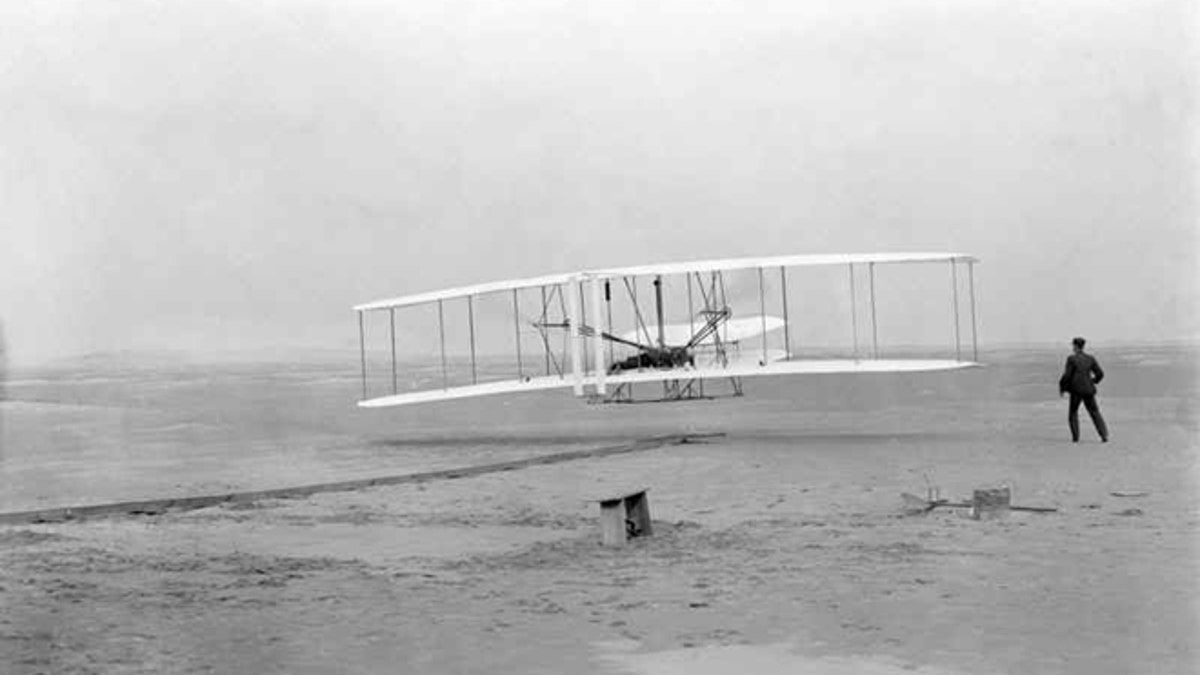
Dec. 17 1903: The first flight by Wright brothers Ovrville and Wilbur, at Kitty Hawk, North Carolina.
Were the Wright brothers first in flight? Read the fine print.
A little-known 1948 contract between the estate of Orville Wright and the Smithsonian has the museum legally bound to call the Wright brothers first in flight: "The Smithsonian shall [not state] any aircraft ... earlier than the Wright aeroplane of 1903 ... was capable of carrying a man under its own power in controlled flight," it states.
One aviation historian claims that contract is wrong, however, forcing the museum to ignore the truth. And for the first time, the museum has released the contract publicly to FoxNews.com, to let the world make its own decisions.
According to most anyone you ask, Orville and Wilbur sailed into history books on Dec. 17, 1903, following their historic flight at Kitty Hawk, North Carolina. The Smithsonian features the Wright Flyer prominently today.
Read the fine print
A 1948 contract between the Smithsonian museum and Orville Wright requires the museum to call the Wright Flyer the first real airplane, critics argue. Here, the relevant excerpt from the contract:
“Neither the Smithsonian Institution nor its successors, nor any museum or other agency ... or its successors shall publish or permit to be displayed a statement or label in connection with or in respect of any aircraft model or design of earlier date than the Wright Aeroplane of 1903, claiming in effect that such aircraft was capable of carrying a man under its own power in controlled flight.”
But Australian aviation historian John Brown argues that a recently uncovered photograph proves German immigrant Gustav Whitehead flew first (over Connecticut, in the wee hours of Aug. 14, 1901). Brown says the Smithsonian is bound by that contract to ignore Whitehead’s feat. And the secrecy has to go, he wrote last week to the Smithsonian’s senior curator.
“With apologies to Ronald Reagan and Mikhail Gorbachev: ... Mr. Crouch, tear up that contract!”
The contract was signed in 1948 between surviving Wright brother Orville and the museum; it secured ownership of the Flyer from London’s Science Museum for $1, with a stipulation: The Wright plane must always be recognized as the first true airplane.
“Jane’s: All the World’s Aircraft” -- widely considered the essential bible of flight -- recently acknowledged Whitehead's achievement, and agreed with Brown about the contract.
“History is normally written by researchers who have dispassionately analyzed all relevant data and not, as here, by the lawyers of interested parties,” the book reads.
The contract does exist and still holds, said Tom Crouch, senior curator of aeronautics at the museum, in a recent blog post.
"The contract remains in force today, a healthy reminder of a less-than-exemplary moment in Smithsonian history."
The Smithsonian was involved in pioneering efforts to achieve flight in the first years of the 20th century, it turns out. An airplane created by the museum was on display in the teens, labelled “first airplane capable of flight.”
'On the surface, yes this agreement does exist … and the agreement has never been secret.'
“That was a very misleading statement,” Peter Jakab, associate director of curatorial affairs for the Smithsonian Museum, told FoxNews.com -- one that angered Orville.
Wright sent his plane to London in 1928 in protest, with Charles Lindbergh's help, where it remained until 1942 when the museum published an extensive article about the Smithsonian's "Langley plane" that set the record straight.
“The plane was put in storage during World War II at a quarry with the Magna Carta and the crown jewels. After the war, arrangements were made to bring it back,” Jakab said.
Those arrangements were between the executors of the estate -- Orville having died of a heart attack -- and the Smithsonian. To avoid paying high taxes on the transfer, a contract was signed.
“The executors put in the agreement a label that always would be displayed with the flyer … directed toward the Langley issue,” he told FoxNews.com.
In an open letter sent March 24 to the Smithsonian's Crouch, Brown argued that the letter was coloring his view of history.
“You saying the Wrights flew first is like Bill Gates saying Microsoft products are good -- except that Bill is more credible because no contract actually requires him to say that,” Brown wrote.
In an open response two days later, Crouch dismissed those claims.
“I can only repeat that if substantial evidence of a pre-Wright flight claim were to be produced, I hope I would have the courage to admit it.”
Ultimately, the question of who flew first is less important than the legacy left by the Wright's design anyway, Jakab argued.
“[The Wright Flyer] was able to evolve into something we have today. And that’s its real powerful significance -- in addition to being the first to fly.”



















